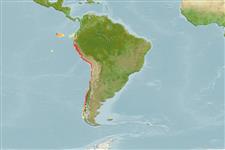Classification / Names
Common names | Synonyms | Catalog of Fishes(genus, species) | ITIS | CoL | WoRMS | Cloffa
Teleostei (teleosts) >
Lophiiformes (Anglerfishes) >
Oneirodidae (Dreamers)
Etymology: Chaenophryne: Greek, 'chaeno' or 'chaino' = to gape + Greek, 'phryne' = toad (alluring to a "gaping toad") (Ref. 86949); quasiramifera: Name from Latin 'quasi' meaning simulating or appearing 'as if', and 'ramifera', refes to the similarity of its esca to its congener C. ramifera..
Environment: milieu / climate zone / depth range / distribution range
Ecology
Marine; bathydemersal; depth range 0 - 1130 m (Ref. 75756). Deep-water
Southeast Pacific: Peru-Chile Trench and Nasca Ridge.
Size / Weight / Age
Maturity: Lm ? range ? - ? cm
Max length : 9.8 cm SL male/unsexed; (Ref. 75756)
Short description
Identification keys | Morphology | Morphometrics
Dorsal soft rays (total): 8; Anal soft rays: 6. This species can be easily distinguished from its congeners in having the following characters: 1 or 2 elongate illicial filaments originating laterally just below base of escal bulb (vs. C. ramifera with 7-12 on each side; descending escal appendage extending along anterior margin of illicium, a small proximal portion emerging at articulation of illicium and illicial pterygiophores as a free, anterodorsally directed tentacle; short illicium, 21.1-22.9% SL; greater number of dorsal- and anal-fin rays, 8 and 6, respectively (Ref. 75756).
Life cycle and mating behavior
Maturities | Reproduction | Spawnings | Egg(s) | Fecundities | Larvae
Pietsch, T.W., 2007. A new species of the ceratioid anglerfish genus Chaenophryne Regan (Lophiiformes: Oneirodidae) from the Eastern Tropical Pacific Ocean. Copeia 2007(1):163-168. (Ref. 75756)
IUCN Red List Status (Ref. 130435)
Threat to humans
Harmless
Human uses
Tools
Special reports
Download XML
Internet sources
Estimates based on models
Preferred temperature (Ref.
123201): 7.6 - 13.3, mean 9.7 °C (based on 38 cells).
Phylogenetic diversity index (Ref.
82804): PD
50 = 0.5312 [Uniqueness, from 0.5 = low to 2.0 = high].
Bayesian length-weight: a=0.01995 (0.00906 - 0.04395), b=3.01 (2.83 - 3.19), in cm total length, based on all LWR estimates for this body shape (Ref.
93245).
Trophic level (Ref.
69278): 3.7 ±0.5 se; based on size and trophs of closest relatives
Resilience (Ref.
120179): High, minimum population doubling time less than 15 months (Preliminary K or Fecundity.).
Fishing Vulnerability (Ref.
59153): Low vulnerability (10 of 100).
